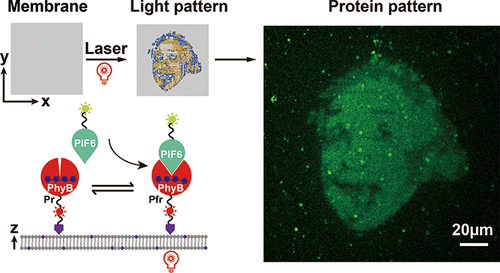当前位置:
X-MOL 学术
›
Nano Lett.
›
论文详情
Our official English website, www.x-mol.net, welcomes your feedback! (Note: you will need to create a separate account there.)
Light-Induced Printing of Protein Structures on Membranes in Vitro
Nano Letters ( IF 10.8 ) Pub Date : 2018-10-08 00:00:00 , DOI: 10.1021/acs.nanolett.8b03187 Haiyang Jia 1 , Lei Kai 1 , Michael Heymann 1 , Daniela A. García-Soriano 1, 2 , Tobias Härtel 1 , Petra Schwille 1
Nano Letters ( IF 10.8 ) Pub Date : 2018-10-08 00:00:00 , DOI: 10.1021/acs.nanolett.8b03187 Haiyang Jia 1 , Lei Kai 1 , Michael Heymann 1 , Daniela A. García-Soriano 1, 2 , Tobias Härtel 1 , Petra Schwille 1
Affiliation

|
Reconstituting functional modules of biological systems in vitro is an important yet challenging goal of bottom-up synthetic biology, in particular with respect to their precise spatiotemporal regulation. One of the most desirable external control parameters for the engineering of biological systems is visible light, owing to its specificity and ease of defined application in space and time. Here we engineered the PhyB-PIF6 system to spatiotemporally target proteins by light onto model membranes and thus sequentially guide protein pattern formation and structural assembly in vitro from the bottom up. We show that complex micrometer-sized protein patterns can be printed on time scales of seconds, and the pattern density can be precisely controlled by protein concentration, laser power, and activation time. Moreover, when printing self-assembling proteins such as the bacterial cytoskeleton protein FtsZ, the targeted assembly into filaments and large-scale structures such as artificial rings can be accomplished. Thus, light mediated sequential protein assembly in cell-free systems represents a promising approach to hierarchically building up the next level of complexity toward a minimal cell.
中文翻译:

体外光诱导膜上蛋白质结构的印刷
在体外重建生物系统的功能模块是自下而上的合成生物学的一个重要而又具有挑战性的目标,特别是在其精确的时空调控方面。生物系统工程最需要的外部控制参数之一是可见光,这是因为可见光的特殊性以及在空间和时间上易于定义的应用。在这里,我们设计了PhyB-PIF6系统,以通过光照将蛋白质时空靶向到模型膜上,从而从下至上依次引导体外的蛋白质图案形成和结构组装。我们表明,可以在几秒的时间范围内打印出微米级大小的复杂蛋白质图案,并且可以通过蛋白质浓度,激光功率和激活时间精确控制图案密度。而且,当打印自组装蛋白(例如细菌细胞骨架蛋白FtsZ)时,可以将目标组装成细丝和大规模结构(如人造环)。因此,在无细胞系统中光介导的顺序蛋白质组装代表了一种有希望的方法,可以逐步将复杂性的下一个层次构建为最小的细胞。
更新日期:2018-10-08
中文翻译:

体外光诱导膜上蛋白质结构的印刷
在体外重建生物系统的功能模块是自下而上的合成生物学的一个重要而又具有挑战性的目标,特别是在其精确的时空调控方面。生物系统工程最需要的外部控制参数之一是可见光,这是因为可见光的特殊性以及在空间和时间上易于定义的应用。在这里,我们设计了PhyB-PIF6系统,以通过光照将蛋白质时空靶向到模型膜上,从而从下至上依次引导体外的蛋白质图案形成和结构组装。我们表明,可以在几秒的时间范围内打印出微米级大小的复杂蛋白质图案,并且可以通过蛋白质浓度,激光功率和激活时间精确控制图案密度。而且,当打印自组装蛋白(例如细菌细胞骨架蛋白FtsZ)时,可以将目标组装成细丝和大规模结构(如人造环)。因此,在无细胞系统中光介导的顺序蛋白质组装代表了一种有希望的方法,可以逐步将复杂性的下一个层次构建为最小的细胞。



























 京公网安备 11010802027423号
京公网安备 11010802027423号